Sql Training - 15
SELECT GetDate();
SELECT ISDATE('1/08/13') AS "MM/DD/YY";
SELECT DISTINCT EmpName FROM Employees
Option 1: Change SQL Server Password in Management StudioIf you've forgotten the sa password for your SQL server, you are probably in a panic. Fear not, for you can change the password and once again have access to the powers of the SA account using Windows Authentication mode.
----------------------------------------- Triggers in SQL ServerA trigger is a set of SQL statements that reside in system memory with unique names. It is a specialized category of stored procedure that is called automatically when a database server event occurs. Each trigger is always associated with a table. A trigger is called a special procedure because it cannot be called directly like a stored procedure. The key distinction between the trigger and procedure is that a trigger is called automatically when a data modification event occurs against a table. A stored procedure, on the other hand, must be invoked directly. The following are the main characteristics that distinguish triggers from stored procedures:
Syntax of TriggerWe can create a trigger in SQL Server by using the CREATE TRIGGER statement as follows: The parameter descriptions of this syntax illustrate below: schema: It is an optional parameter that defines which schema the new trigger belongs to. trigger_name: It is a required parameter that defines the name for the new trigger. table_name: It is a required parameter that defines the table name to which the trigger applies. Next to the table name, we need to write the AFTER clause where any events like INSERT, UPDATE, or DELETE could be listed. NOT FOR REPLICATION: This option tells that SQL Server does not execute the trigger when data is modified as part of a replication process. SQL_Statements: It contains one or more SQL statements that are used to perform actions in response to an event that occurs. When we use triggers?Triggers will be helpful when we need to execute some events automatically on certain desirable scenarios. For example, we have a constantly changing table and need to know the occurrences of changes and when these changes happen. If the primary table made any changes in such scenarios, we could create a trigger to insert the desired data into a separate table. Example of Trigger in SQL ServerLet us understand how we can work with triggers in the SQL Server. We can do this by first creating a table named 'Employee' using the below statements: Next, we will insert some record into this table as follows: We can verify the insert operation by using the SELECT statement. We will get the below output: 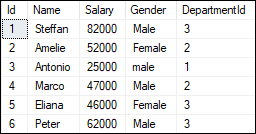 We will also create another table named 'Employee_Audit_Test' to automatically store transaction records of each operation, such as INSERT, UPDATE, or DELETE on the Employee table: Now, we will create a trigger that stores transaction records of each insert operation on the Employee table into the Employee_Audit_Test table. Here we are going to create the insert trigger using the below statement: After creating a trigger, we will try to add the following record into the table: If no error is found, execute the SELECT statement to check the audit records. We will get the output as follows:  We are going to create another trigger to store transaction records of each delete operation on the Employee table into the Employee_Audit_Test table. We can create the delete trigger using the below statement: After creating a trigger, we will delete a record from the Employee table: If no error is found, it gives the message as below:  Finally, execute the SELECT statement to check the audit records:  In both the triggers code, you will notice these lines: Here inserted and deleted are special tables used by the SQL Server. The inserted table keeps the copy of the row when you insert a new row into the actual table. And the deleted table keeps the copy of the row you have just deleted from the actual table. Example: When we insert data into a table, the trigger associated with the insert operation on that table will fire before the data has passed all constraints, such as the primary key constraint. SQL Server also fires the Instead of Trigger if the data insertion fails. The following is an illustration of the Instead of Triggers syntax in SQL Server: Logon TriggersLogon triggers are fires in response to a LOGON event. The LOGON event occurs when a user session is generated with an SQL Server instance, which is made after the authentication process of logging is completed but before establishing a user session. As a result, the SQL Server error log will display all messages created by the trigger, including error messages and the PRINT statement messages. If authentication fails, logon triggers do not execute. These triggers may be used to audit and control server sessions, such as tracking login activity or limiting the number of sessions for a particular login. How to SHOW Triggers in SQL Server?When we have many databases with multiple tables, the show or list trigger comes in handy. When the table names in multiple databases are the same, this query is extremely helpful. Using the following command, we can see a list of all the triggers available in SQL Server: If we are using the SQL Server Management Studio, it is very easy to show or list all triggers available in any specific table. We can do this using the following steps:
We will get various options here. When we choose the Triggers option, it displays all the triggers available in this table. 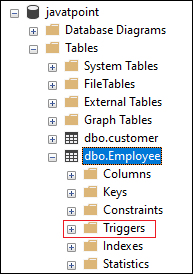 Advantages of TriggersThe following are the advantages of using triggers in SQL Server:
Disadvantages of TriggersThe following are the disadvantages of using triggers in SQL Server:
| ------------------------------------- | CREATE TABLE Employee ( [ID] INT identity(1,1), [FirstName] Varchar(100), [LastName] Varchar(100), [Country] Varchar(100), ) GO Insert into Employee ([FirstName],[LastName],[Country] )values('Raj','Gupta','India'), ('Raj','Gupta','India'), ('Mohan','Kumar','USA'), ('James','Barry','UK'), ('James','Barry','UK'), ('James','Barry','UK') --------------------------------------------- SQL delete duplicate Rows using Common Table Expressions (CTE)We can use Common Table Expressions commonly known as CTE to remove duplicate rows in SQL Server. It is available starting from SQL Server 2005. We use a SQL ROW_NUMBER function, and it adds a unique sequential row number for the row. In the following CTE, it partitions the data using the PARTITION BY clause for the [Firstname], [Lastname] and [Country] column and generates a row number for each row.
In the output, if any row has the value of [DuplicateCount] column greater than 1, it shows that it is a duplicate row.
We can remove the duplicate rows using the following CTE. | DELETE FROM [Employee] | WHERE ID NOT IN | ( | SELECT MAX(ID) AS MaxRecordID | FROM [Employee] | GROUP BY [FirstName], | [LastName], | [Country] | ); | ---------------------- | Question 1: SQL Query to find the second highest salary of Employee Answer: There are many ways to find the second highest salary of an Employee in SQL, you can either use SQL Join or Subquery to solve this problem. Here is an SQL query using Subquery: | SELECT MAX(Salary) | FROM Employees1 | WHERE Salary NOT IN (select MAX(Salary) from Employees ); | Question 2: SQL Query to find Max Salary from each department. Answer: You can find the maximum salary for each department by grouping all records by DeptId and then using MAX() function to calculate the maximum salary in each group or each department | SELECT department_id, MAX(Salary) FROM Employees1 GROUP BY department_id | Question 8: Write an SQL Query to find the name of an employee whose name Start with ‘M’ Answer : SELECT * FROM Employees WHERE EmpName like 'M%'; | Question 10: Write an SQL Query to find the year from date. Answer: Here is how you can find Year from a Date in SQL Server 2008 SELECT YEAR(GETDATE()) as "Year"; | Question 11: Write SQL Query to find duplicate rows in a database? and then write SQL query to delete them? Answer: You can use the following query to select distinct records: SELECT * FROM emp a WHERE rowid = (SELECT MAX(rowid) FROM EMP b WHERE a.empno=b.empno) to Delete: DELETE FROM emp a WHERE rowid != (SELECT MAX(rowid) FROM emp b WHERE a.empno=b.empno); | https://www.guru99.com/sql-interview-questions-answers.html | https://www.interviewbit.com/sql-interview-questions/ |
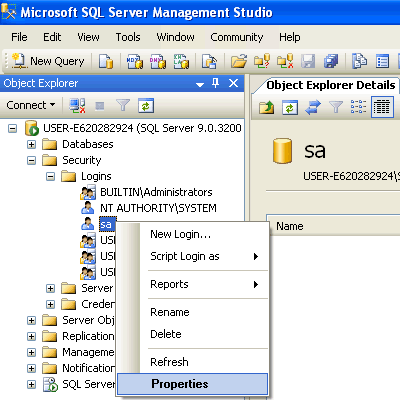
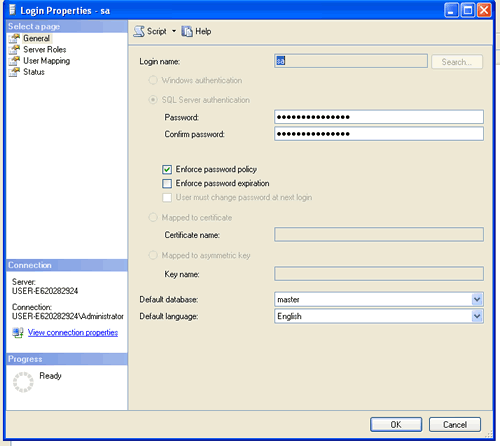
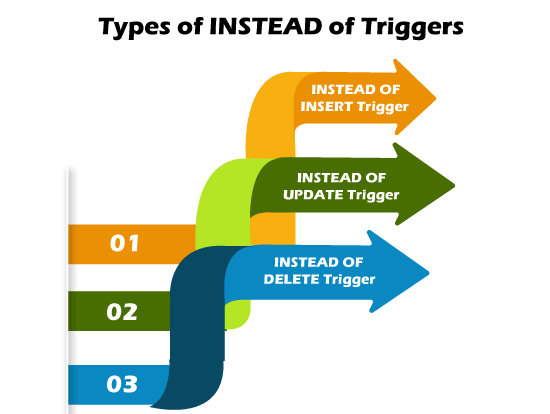
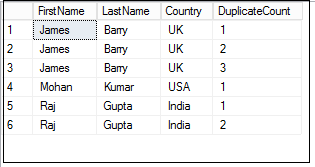

Comments
Post a Comment